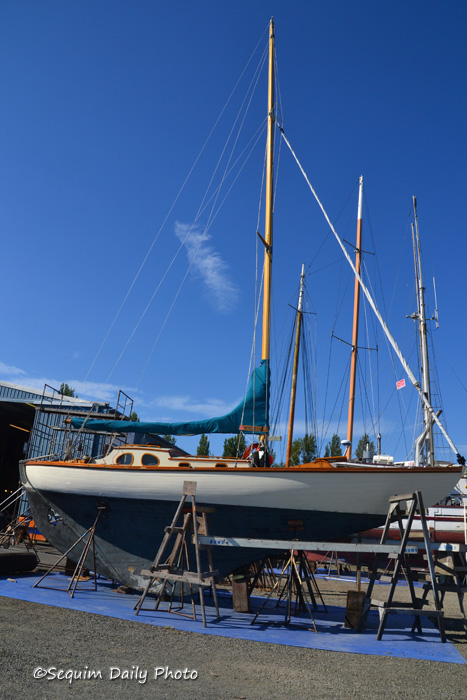I spent a little time in the Port Townsend boatyards last week and noticed this boat. Sailboats usually look so sleek in the water it’s easy to forget how much of the boat is below the waterline.
Category: Boats
Conspicuous consumption
Earth Day
Today is the 45th anniversary of the first Earth Day in 1970. This event was initiated to raise public awareness of environmental issues and to encourage commitment to change and service in an effort to reduce pollution and human impacts on our planet.
So today I will introduce you to Polar Pioneer, a visitor to the Port of Port Angeles. Polar Pioneer is a semi-submersible offshore drilling rig that arrived last week from Malaysia on its way to Arctic waters off Alaska as part of Shell Oil Company’s plans to resume exploratory oil drilling there.
Polar Pioneer is riding piggyback on the Blue Marlin, a heavy-lift ship that can partially submerge to allow the Pioneer to be towed from its deck. After initial work in Port Angeles it will be towed to Seattle for additional fittings. Then it will deploy to Chukchi Sea in northwest coastal Alaska.
The rig has not been warmly welcomed in some circles. Activists cite poorly handled spills around the world to argue that exploration companies are ill-equipped to handle spills. Greenpeace temporarily boarded the Blue Marlin on its journey and activists protested its arrival here. A coalition of groups, Shellno.org plans further protests in Seattle.
Polar Pioneer is 400 feet tall. Though distance alters scale, in this shot it dwarfs the MV Coho, a 341.5 foot passenger ferry that can carry 110 vehicles and 1,000 passengers. Most of us never see these rigs up close and personal. Perhaps we should. I know there are probably many that have worked flawlessly for years. But events such as the Deepwater Horizon disaster in the Gulf of Mexico five years ago are a cautionary tale that time and distance should not erase. Mother Nature is a good housekeeper but not a miracle worker.
Waiting for summer
Silhouette on the Strait
The profile of this ship on the Strait of Juan de Fuca caught my attention last Saturday evening. It was at considerable distance, near the Port of Port Angeles. On Sunday I learned that there was a story behind this ship. It is a 685-foot U.S. Navy Military Sealift Command cargo ship, Cape Intrepid. After an extended docking in Tacoma it was undergoing sea trials when it lost power last Saturday afternoon about 65 miles northwest of Sequim. It drifted in Canadian waters until two emergency tugs towed it to Port Angeles for evaluation. The last I read of its adventure this week was that it was towed from Port Angeles for repairs.
Sequim’s boy in the boat
There’s a best selling book called “The Boys in The Boat” by Daniel James Brown. Here’s a link to a short YouTube video about it. It’s a wonderful book about an improbable group of young men, a crew team from University of Washington, and their quest for gold at the Berlin Olympics in 1936. One of the team, Joe Rantz, came from Sequim (shown in the video and described as a “small dusty town”). Our local Museum and Arts Center (MAC) currently has an exhibit on “The Boys in the Boat,” including a smaller version of their rowing shell and memorabilia contributed by Joe Rantz’s family. The shell, Working Girl, designed and built by George Yeoman Pocock, is shown above.
Pocock revolutionized rowing shells by fitting together two long, single planks rather than multiple narrow strakes, or planks, creating lighter, more streamlined vessels. Working Girl has four positions; the University of Washington Pocock shell had eight.
In addition to the rowing shell, the exhibit includes copies of some of Rantz’s travel documents and high school keepsakes. My favorite personal item was a postcard Rantz sent his father: “Dear Pa, Here is a view of the finish of the race course where the world championship race takes place next week. By the time you get this I’ll either be chump or champ.”
The MAC is a small museum but it’s got a little bit of everything, including art, an exhibit on the local S’Klallam tribe, information about Sequim’s famous mastodon, and more. Tomorrow I’ll tell you about MAC’s Friday duck celebrity.
Last look around the museum
There was so much to see at the Columbia River Maritime Museum! There were, as expected, classic model ships, a micro view of maritime life.
No maritime museum would be complete without a little scrimshaw. This interesting piece was carved on an ostrich egg.
Our original plan was to breeze through the maritime museum and then explore the beautiful little city of Astoria, where it’s located. Perhaps we’d have a little lunch and then head on to our family visit in Portland. Nope. We spent hours in the museum and never made it onto the boats exhibited outside. This is one of the few shots I took of Astoria, before the museum. Sweet looking place, no? We’ve must go back. And, yes. We’ll hit the museum again, too.
Here’s a link to the museum if you want to learn more about it.
************************************
Final reminder to City Daily Photo bloggers: The photo challenge for February 1st is If you had to leave forever the city from which you usually post, what would you miss most?
************************************













